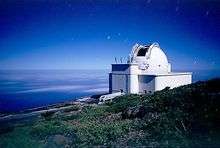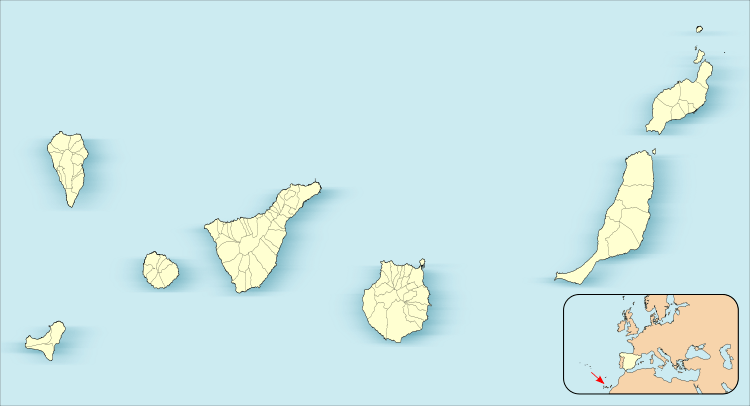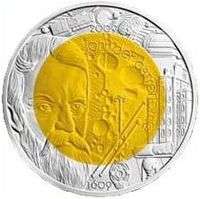Isaac Newton Telescope
 The INT dome by moonlight | |
| Observatory |
Isaac Newton Group of Telescopes Roque de los Muchachos Observatory Royal Observatory |
|---|---|
| Location(s) |
La Palma, Spain |
| Coordinates |
28°45′44″N 17°52′39″W / 28.7622°N 17.8775°WCoordinates: 28°45′44″N 17°52′39″W / 28.7622°N 17.8775°W |
| Organization |
Isaac Newton Group of Telescopes |
| Built |
1967 |
| Telescope style |
Cassegrain reflector Newtonian telescope Optical telescope |
| Diameter |
2.54 m (8 ft 4 in) |
| Collecting area |
5 m2 (54 sq ft) |
| Focal length |
8.36 m (27 ft 5 in) |
| Mounting |
Equatorial mount |
| Enclosure |
Spherical dome |
| Website |
www |
 Location of Isaac Newton Telescope | |
The Isaac Newton Telescope or INT is a 2.54 m (100 in.) optical telescope run by the Isaac Newton Group of Telescopes at Roque de los Muchachos Observatory on La Palma in the Canary Islands since 1984.
Originally the INT was situated at Herstmonceux Castle in Sussex, England, which was the site of the Royal Greenwich Observatory after it moved away from Greenwich due to light pollution. It was inaugurated in 1967 by Queen Elizabeth II.[1]
Herstmonceux suffered from poor weather, and the advent of mass air travel made it plausible for UK astronomers to run an overseas observatory. In 1979, the INT was shipped to La Palma, where it has remained ever since. It saw its second first light in 1984, with a video camera.[2][3]
Today, it is used mostly with the Wide Field Camera (WFC), a four CCD instrument with a field of view of 0.56x0.56 square degrees which was commissioned in 1997. The other main instrument available at the INT is the Intermediate Dispersion Spectrograph (IDS), recently re-introduced having been unavailable for a period of several years.
Technical detail since 1984
The La Palma INT is a Cassegrain telescope, with a 2.54 m (100 in) diameter primary mirror and a focal length of 8.36 m (329 in). The mirror weighs 4361 kg (9614 lb), and is supported by a polar disc/fork type equatorial mounting. The total weight of the telescope is around 90 tons. The f/3.29 Prime focus, used with the WFC, allows an unvignetted field of view of 40 arcminutes (approximately 0.3 square degrees). There is also a secondary focal station, the f/15 Cassegrain focus, which possesses a 20 arcminute field of view and is the mount point for the IDS. The telescopes second first light was done by video.[3]
The pointing accuracy of the telescope is around 5 arcseconds, but a sophisticated autoguider, which tracks a given guide star and makes small corrections to the telescope tracking, allows a guiding accuracy of better than an arcsecond on better than 20th magnitude guide stars in support of the typical 0.8-1.5 arcsec seeing at the INT.


Contemporaries
The Isaac Newton Telescope was a very large telescope for its day, and the largest in England. It was a little smaller in aperture than the 100-inch Hooker telescope in the United States, but much newer. It originally had a 98-inch mirror when in England, but given a new, larger 100-inch mirror by Grubb Parsons after the move.[4][5] INT locations are Herstmonceux Castle (1967–79) then ORM (1984–).
1967
The INT was inaugurated by Queen Elizabeth II in 1967.
Largest optical telescopes 1967:
| # | Name / Observatory |
Image | Aperture | Altitude | First Light |
|---|---|---|---|---|---|
| 1 | 5m Hale Telescope Palomar Obs. |
200″ 508 cm |
1713 m (5620 ft) |
1949 | |
| 2 | C. Donald Shane telescope Lick Observatory |
120″ 305 cm |
1283 m (4209 ft) |
1959 | |
| 3 | Shajn 2.6m (Crimean 102 in.) Crimean Astrophysical Obs. |
102″ 260 cm |
600 m (1969 ft) [6] |
1961 | |
| 4 | Hooker Telescope Mount Wilson Obs. |
100″ 254 cm |
1742 m (5715 ft) |
1917 | |
| 5 | Isaac Newton Telescope Royal Greenwich Obs. (1967-1979) |
98″ 249 cm |
1965 [2] | ||
| 6 | KPNO 2.1 m Telescope Kitt Peak National Obs. |
83″ 211 cm |
2,070 m 6791 ft |
1964 | |
| 7 | Otto Struve Telescope McDonald Obs. |
82″ 208 cm |
2070 m (6791 ft) |
1939 |
1984
INT began its new life atop the Canary Island of La Palma, a Spanish mountain island, in 1984, with a new mirror and dome.
Large visible-light optical ground telescopes in 1984:
| Name / Observatory |
Image | Aperture | M1 Area |
Altitude | First Light | |
|---|---|---|---|---|---|---|
| n | BTA-6 Special Astrophysical Obs |
238″ 605 cm |
26 m² | 2070 m (6791 ft) |
1975 | |
| n | Hale Telescope Palomar Obs. |
200″ 508 cm |
20 m² | 1713 m (5620 ft) |
1949 | |
| n | Multiple Mirror Telescope Fred Lawrence Whipple Obs. |
1.8 m x 6 6+ or 4.7 m |
m² | 2617 m (8585 ft) |
1979 | |
| n | Mayall Telescope Kitt Peak National Obs. |
158″ 401 cm |
10 m² | 2120 m (6955 ft) |
1973 | |
| s | CTIO 4m/Blanco CTIO Obs. |
158″ 401 cm |
10 m² | 2200 m (7217 ft) |
1976 | |
| s | Anglo-Australian Telescope Siding Spring Obs. |
153″ 389 cm |
m² | 1742 m (5715 ft) |
1974 | |
| n | CFH telescope Mauna Kea Obs. |
141″ 358 cm |
m² | 4205 m (13,800 ft) |
1979 | |
| s | ESO 3.6 m Telescope ESO La Silla Obs. |
140″ 357 cm |
8.8 m² | 2400 m (7874 ft) |
1977 | |
| n | MPI-CAHA 3.5m Calar Alto Obs. |
138″ 350 cm |
9 m² [7] |
2168 m (7,113 ft) |
1984 | |
| n | Shane Telescope Lick Observatory |
120″ 305 cm |
m² | 1283 m (4209 ft) |
1959 | |
| n | Harlan J. Smith Telescope McDonald Observatory |
107″ 270 cm |
2070 m (6791 ft) |
1968 | ||
| n | Shajn 2.6m (Crimean 102 in.) Crimean Astrophysical Obs. |
102″ 260 cm |
600 m (1969 ft) [6] |
1961 | ||
| n | BAO 2.6 telescope Byurakan Astrophysical Obs. |
102″ 260 cm |
1500 m (5000 ft) |
1976 | ||
| n | Isaac Newton Telescope ORM Obs. (1980–Present) |
100″ 254 cm |
2396 m (7,860 ft) |
1984 [2] | ||
| s | du Pont telescope Las Campanas Obs. |
100″ 254 cm |
2380 m (7841 ft) |
1976 | ||
| n | Hooker Telescope Mount Wilson Obs. |
100″ 254 cm |
1742 m (5715 ft) |
1917 |
See also
References
- ↑ Smith, F. Graham; Dudley, J. (1982). "The Isaac Newton Telescope". Journal for the History of Astronomy. 12 (1): 1–18. Bibcode:1982JHA....13....1S. doi:10.1177/002182868201300101. Retrieved 18 February 2016.
- 1 2 3 http://www.ing.iac.es/PR/chronology.html
- 1 2 New Scientist Feb 16, 1984
- ↑ Macdonald, Lee T. (2012). "`A Large Chunk of Glass': The 98-inch Mirror of the Isaac Newton Telescope, 1945–1959". The Antiquarian Astronomer. Society for the History of Astronomy. 6: 59–73. Bibcode:2012AntAs...6...59M. Retrieved 6 November 2015.
- ↑ McCrea, William Hunter (1975). Royal Greenwich Observatory : an Historical Review Issued on the Occasion of its Tercentenary. London: Her Majesty's Stationery Office. Bibcode:1975rgo..book.....M.
- 1 2 "Archived copy". Archived from the original on 2011-07-20. Retrieved 2010-01-13.
- ↑ CA 3.5 Specs
External links
- INT Homepage
- Merrifield, Michael; Barrena, Rafael. "Isaac Newton Telescope". Deep Sky Videos. Brady Haran.